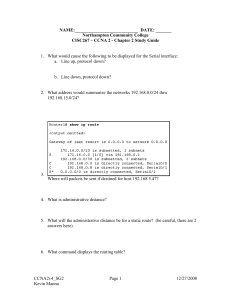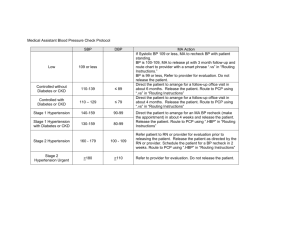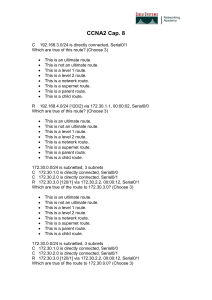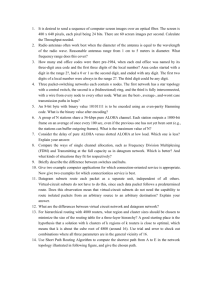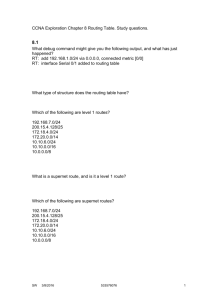CCNA Exploration Chapter 9 Ethernet
advertisement
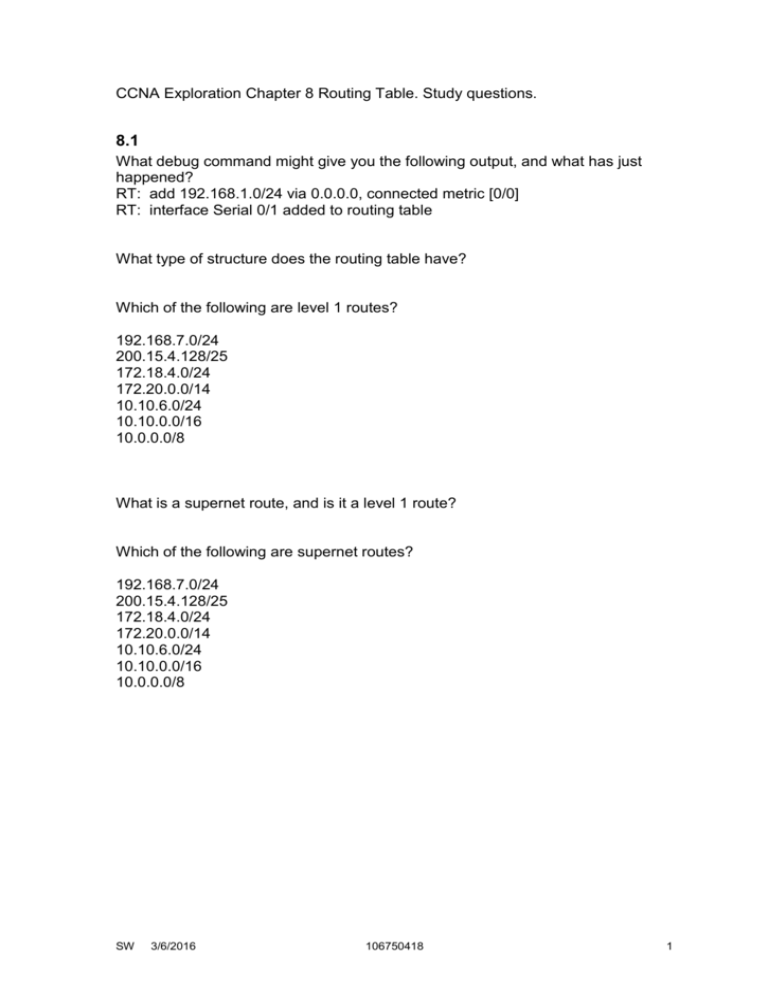
CCNA Exploration Chapter 8 Routing Table. Study questions. 8.1 What debug command might give you the following output, and what has just happened? RT: add 192.168.1.0/24 via 0.0.0.0, connected metric [0/0] RT: interface Serial 0/1 added to routing table What type of structure does the routing table have? Which of the following are level 1 routes? 192.168.7.0/24 200.15.4.128/25 172.18.4.0/24 172.20.0.0/14 10.10.6.0/24 10.10.0.0/16 10.0.0.0/8 What is a supernet route, and is it a level 1 route? Which of the following are supernet routes? 192.168.7.0/24 200.15.4.128/25 172.18.4.0/24 172.20.0.0/14 10.10.6.0/24 10.10.0.0/16 10.0.0.0/8 SW 3/6/2016 106750418 1 Which of the following are network routes? 192.168.7.0/24 200.15.4.128/25 172.18.4.0/24 172.20.0.0/14 10.10.6.0/24 10.10.0.0/16 10.0.0.0/8 Level 1 routes include supernet and network routes. What is another kind of level 1 route? How can a router obtain information about level 1 routes? What is an ultimate route? Can a level 1 route be an ultimate route? A routing table includes the following: 192.168.1.0/27 is subnetted, 1 subnets 192.168.1.32 is directly connected, FastEthernet0/0 Which is the parent route and which is the child route? What level of route is a child route, and what is special about its subnet mask? Serial 0/0 is configured with IP address 172.16.5.0 255.255.255.0 and enabled. What entries would you expect to see in the routing table? Sometimes the parent route includes the subnet mask that is being used by its child routes and sometimes it does not. Why? If all child routes are deleted, what happens to their parent route? It is deleted. SW 3/6/2016 106750418 2 8.2 A routing table is as follows: 172.16.0.0/16 is variably subnetted, 3 subnets, 2 masks C 172.16.1.4/30 is directly connected, Serial 0/0 C 172.16.1.8/30 is directly connected, Serial 0/1 C 172.16.1.0/24 is directly connected, FastEthernet 0/0 C 192.168.3.0/24 is directly connected, FastEthernet 0/1 S* 0.0.0.0/0 is directly connected, Serial0/0 What happens when a packet arrives addressed to 192.168.3.21? A routing table is as follows: 172.16.0.0/16 is variably subnetted, 3 subnets, 2 masks C 172.16.1.4/30 is directly connected, Serial 0/0 C 172.16.1.8/30 is directly connected, Serial 0/1 C 172.16.1.0/24 is directly connected, FastEthernet 0/0 C 192.168.3.0/24 is directly connected, FastEthernet 0/1 S* 0.0.0.0/0 is directly connected, Serial0/0 What happens when a packet arrives addressed to 172.16.1.81? A routing table is as follows: 172.16.0.0/16 is variably subnetted, 3 subnets, 2 masks C 172.16.1.4/30 is directly connected, Serial0/0 C 172.16.1.8/30 is directly connected, Serial0/1 C 172.16.1.0/24 is directly connected, FastEthernet0/0 C 192.168.3.0/24 is directly connected, FastEthernet0/1 S* 0.0.0.0/0 is directly connected, Serial0/0 Classful routing is in use. What will happen when a packet arrives addressed to 172.16.8.7? A routing table is as follows: 172.16.0.0/16 is variably subnetted, 3 subnets, 2 masks C 172.16.1.4/30 is directly connected, Serial0/0 C 172.16.1.8/30 is directly connected, Serial0/1 C 172.16.1.0/24 is directly connected, FastEthernet0/0 C 192.168.3.0/24 is directly connected, FastEthernet0/1 S* 0.0.0.0/0 is directly connected, Serial0/0 Classless routing is in use. What will happen when a packet arrives addressed to 172.16.8.7? SW 3/6/2016 106750418 3 A routing table is as follows: 172.16.0.0/16 is variably subnetted, 3 subnets, 2 masks C 172.16.1.4/30 is directly connected, Serial0/0 C 172.16.1.8/30 is directly connected, Serial0/1 C 172.16.1.0/24 is directly connected, FastEthernet0/0 C 192.168.3.0/24 is directly connected, FastEthernet0/1 S* 0.0.0.0/0 is directly connected, Serial0/0 Classful routing is in use. What will happen when a packet arrives addressed to 172.17.8.7? A routing table is as follows: 172.18.0.0/24 is subnetted, 3 subnets C 172.18.1.0 is directly connected, Serial 0/0 C 172.18.2.0 is directly connected, Serial 0/1 C 172.18.3.0 is directly connected, FastEthernet 0/0 C 192.168.9.0/24 is directly connected, FastEthernet 0/1 S* 0.0.0.0/0 is directly connected, Serial0/0 A packet arrives addressed to 172.18.3.21. How many bits of this address must match level 1 address 172.18.0.0 in order to allow a comparison with the child addresses? What is the effect of the ip classless command? A router has no ip classless in its configuration. It is running RIPv1. Is it possible to change to RIPv2? SW 3/6/2016 106750418 4



